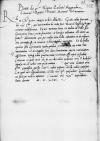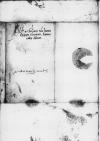List #2998
Bona Sforza do Ioannes DANTISCUSCracow (Kraków), 1546-09-20
| odebrano Graudenz (Grudziądz), 1546-09-29 Rękopiśmienne podstawy źródłowe:
| ||||
Tekst + aparat krytyczny + komentarz Zwykły tekst Tekst + komentarz Tekst + aparat krytyczny
Reverendo in Christo Patri, Domino
Reverende in Christo Pater sincere nobis dilecte.
Gratae nobis fuerunt cf.
Et de bellis quidem istis Germanicis multa quidem, verum falsa ac vana huc nuntiantur et in singulos fere dies commutantur iuxta varietatem affectuum, quisque enim partem suam victricem esse cupit et scribit. Ceterum, si quid certi de iis ac aliis rebus externis Vestra Paternitas habebit, significare id nobis non praetermittat.
Quae vero commisit Vestra Paternitas
Quam salvam paper damaged⌈[m]m paper damaged⌉ ac felicem valere optamus.


 BCz, 3465, p. 328
BCz, 3465, p. 328